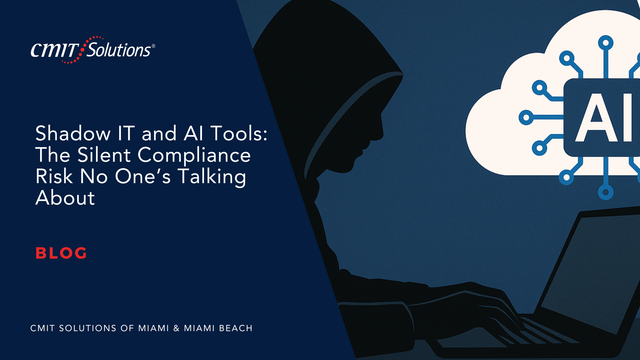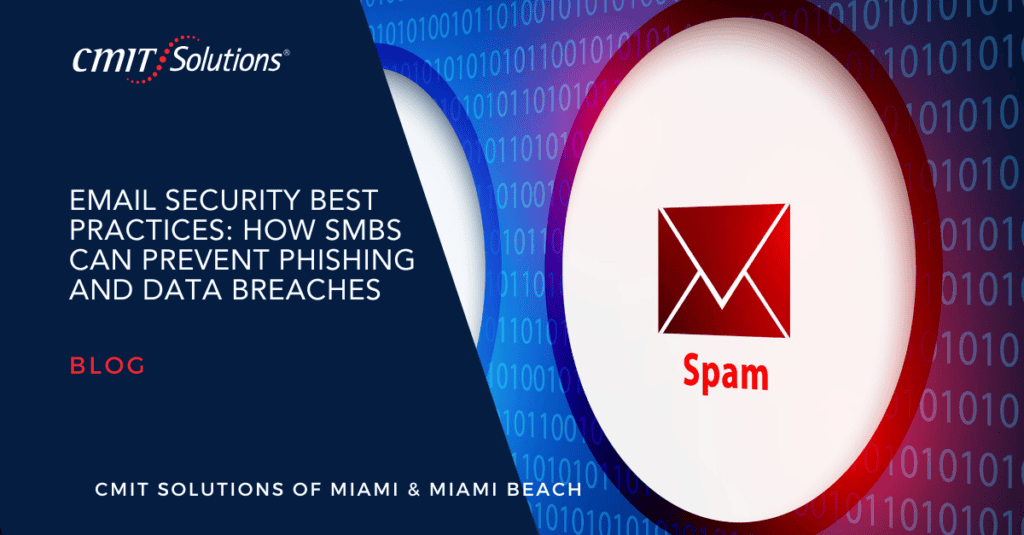Introduction
Artificial intelligence (AI) is no longer a novelty for small and midsize businesses—it’s woven into everyday workflows. From chatbots that draft contracts to image generators that cut design costs, AI promises faster results and lower overhead. But those gains can disappear overnight if the tools employees adopt on their own—better known as Shadow IT—drag sensitive data outside your approved environment. In Miami’s fast‑moving business scene, where innovation is prized and time is scarce, Shadow IT often flies under the radar until a compliance audit—or a breach—makes it painfully visible.
The good news? You can harness AI without sacrificing security. Below, we explore seven in‑depth topics that outline where Shadow IT and AI overlap, how that overlap threatens compliance, and what Miami‑based companies can do today to regain control.
What Is Shadow IT?
Shadow IT refers to technology solutions—hardware, software, or cloud services—used within an organization without explicit IT department approval. While it often stems from good intentions, like improving productivity or overcoming workflow hurdles, the use of unvetted tools introduces major risks. These include data exposure, regulatory noncompliance, and operational inefficiencies.
Employees in fast-paced environments like Miami often turn to third-party AI platforms for their speed and convenience. However, without centralized oversight, this creates invisible vulnerabilities. Understanding what constitutes Shadow IT is the first step in building defenses that scale with innovation.
Shadow IT in the Age of AI: A Double‑Edged Sword
Shadow IT has been around since the early days of digital workspaces—think USB flash drives, rogue Wi-Fi hotspots, and personal Gmail accounts. But AI has changed the game. Today’s tools are smart, stealthy, and easily accessible. A single employee can now plug an entire AI engine into their workflow without downloading a thing, bypassing IT governance entirely.
These AI tools often promise seamless integration, personalized automation, and productivity boosts. Unfortunately, they rarely come with security disclaimers or compliance guarantees. For small businesses trying to stay nimble and competitive, it’s easy to understand the temptation. However, what begins as a harmless shortcut—like pasting sensitive business data into an AI prompt—can become a vector for data breaches, compliance violations, and brand damage.
The minute an operations manager pastes customer data into a generative language model, that data may be copied, cached, or stored on servers outside your jurisdiction. From that point on, you’ve lost control—and possibly your legal protections.
Unauthorized AI use also makes it nearly impossible to meet strict mandates such as HIPAA, PCI‑DSS, or GDPR. CMIT Solutions of Miami & Miami Beach routinely uncovers hidden accounts when conducting baseline managed IT services assessments. By flagging every unsanctioned application, our team closes loopholes before auditors or cybercriminals exploit them. The minute an operations manager pastes customer data into a generative language model, that data may be copied, cached, or stored on servers outside your jurisdiction.
Unauthorized AI use also makes it nearly impossible to meet strict mandates such as HIPAA, PCI‑DSS, or GDPR. CMIT Solutions of Miami & Miami Beach routinely uncovers hidden accounts when conducting baseline managed IT services assessments. By flagging every unsanctioned application, our team closes loopholes before auditors or cybercriminals exploit them.
Compliance Minefields: Where Shadow IT and AI Collide
Regulators care less about how data leaves your environment and more about the fact that it does. AI tools create multiple compliance minefields:
- Data Residency – Many AI vendors process information in foreign jurisdictions. If personal data crosses borders without contractual safeguards, you could violate Florida statutes on data privacy and even the EU’s GDPR. For businesses subject to local statutes, our IT compliance roadmap outlines how to keep data where it belongs.
- Opaque Supply Chains – Popular AI APIs often lean on subcontractors for model training or hosting, increasing third‑party risk.
- Loss of Encryption – Uploading files through unsecured web forms can strip end‑to‑end encryption, putting payment information at risk.
These pitfalls become exponentially harder to monitor when each department spins up its own AI account. A formal Acceptable Use Policy helps, but only layered security controls and continuous visibility make that policy enforceable.
Invisible Data Exposure Paths You Might Be Missing
Even businesses that believe they have Shadow IT under control often underestimate the ways data can slip away:
- Browser Extensions that read every page—including web‑based HR portals.
- AI Meeting Bots that record calls and store transcripts in unsecured clouds.
- Free Image Generators that embed original uploads into public model training sets.
CMIT Solutions deploys a multi‑layered cybersecurity defense to surface these blind spots. Endpoint monitoring logs unknown executables; firewall analytics spot unusual traffic peaks; and cloud‑access security brokers (CASBs) tag risky SaaS behavior in real time.
Miami SMB Spotlight: Real Stories and Lessons Learned
In Miami’s diverse and fast-paced small business ecosystem, digital innovation often outpaces oversight. But real-world stories show us that what starts as a harmless tech shortcut can quickly evolve into a costly compliance or security issue. Below are a few extended examples that illustrate how Shadow IT and unchecked AI adoption impacted local organizations—and how swift intervention helped them recover or improve their posture moving forward.
An Architecture Firm’s Close Call
A junior designer pasted blueprints into a free AI tool to generate cost estimates. Weeks later, a competitor released a project strikingly similar—proof that the AI vendor had absorbed proprietary data into its public model.
Healthcare Startup Under HIPAA Scrutiny
A receptionist used ChatGPT to draft patient appointment reminders. During a HIPAA audit, investigators found unencrypted Protected Health Information (PHI) stored on a third‑party server. The firm avoided fines only after demonstrating immediate remediation through proactive IT maintenance.
E‑Commerce Brand and PCI‑DSS
Marketing pushed customer emails into an AI segmentation tool with inadequate encryption. The resulting data leak cost the brand thousands in credit‑card‑monitoring fees—an expense that dwarfed the original subscription savings.
These cautionary tales underscore the need for cyber‑threat awareness embedded in every department, not just IT.
Building a Zero‑Trust Culture That Discourages Shadow IT
Zero Trust isn’t a product—it’s a mindset. The model assumes no user or device is reliable until proven otherwise, shrinking implicit trust zones and making Shadow IT easier to spot. Practical steps include:
- Strong Identity Governance – Enforce multifactor authentication and least‑privilege access for every SaaS account.
- Continuous Micro‑Segmentation – Network segments prevent lateral movement if an unsanctioned AI tool is compromised.
- User Education – Frequent micro‑trainings keep security top of mind. Our cybersecurity training framework blends real‑world scenarios with phishing simulations tailored to Miami SMB threats.
The culture piece is non‑negotiable: employees who understand the why behind policy are less likely to bypass it.
Governance Frameworks and Tools to Keep AI Under Control
Governance bridges policy and technology, translating rules into actionable controls. Essential components include:
- App Whitelisting – Only allow vetted AI apps inside the corporate environment.
- Secure API Gateways – Route AI queries through gateways that strip or tokenize sensitive data.
- Automated Backups – Pair new workloads with resilient data backup and disaster recovery routines.
- Endpoint Detection & Response – Deploy advanced endpoint security that watches for unusual process launches linked to rogue AI installers.
When these tools operate under a unified dashboard, your IT team—or a partner like CMIT—can enforce policy at machine speed.
Partnering for Continuous Compliance and Innovation
Shadow IT thrives in the gaps between policy reviews, security patches, and employee onboarding cycles. That’s why continuous oversight matters more than one‑time fixes. A strategic partner offers:
- 24×7 Monitoring & Response – Our round‑the‑clock operations center hunts for anomalies even when your office lights are off.
- AI‑Powered Threat Intel – Leveraging AI‑driven cybersecurity keeps defenses adaptive.
- Cost Transparency – We align security budgets with business goals, avoiding the hidden costs of poor IT support.
- Scalable Cloud Expertise – If your roadmap includes hybrid or multi‑cloud, our cloud enablement guidance prevents “cloud sprawl” from creating yet another Shadow IT problem.
Instead of reacting to the latest breach headline, continuous partnership means you’re prepared before threats materialize.
Conclusion
AI will continue to reshape how work gets done. Whether that evolution strengthens or sabotages your organization depends on visibility, governance, and culture. Shadow IT isn’t just an IT issue; it’s a business‑wide risk that threatens compliance, reputation, and profitability.
By embracing Zero Trust, layering defenses, and collaborating with experts, Miami’s SMB community can innovate with confidence. That starts with a candid look at where unsanctioned tools already live inside your network—and a plan to bring them into the light.
Ready to find out what’s lurking behind the scenes? Schedule a no‑obligation audit with CMIT Solutions of Miami & Miami Beach to pinpoint hidden AI and Shadow IT risks before they become tomorrow’s headline.







